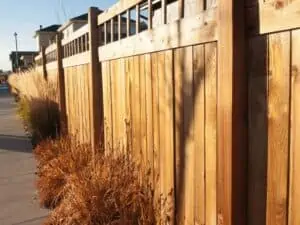How to Tell If a Fence is Cedar Or Pine?
If you’re planning to build a new fence, one of the most important questions is whether to use cedar or pine wood. Both types are great options, but each has its own advantages and drawbacks. Ultimately, you want to choose the type of lumber that best meets your needs.
(Looking for “Wooden Fence Restoration“? Contact us today!)

Aesthetics – Cedar has a warm, rich look and a beautiful grain pattern that’s reminiscent of old-growth redwood. It’s also easy to maintain, and you can stain it if desired.
Durability – Cedar is extremely durable, and it can hold up well against insects, mold, rot, and weather damage. It can last up to 30 years or more with proper maintenance.
Eco-Friendly – Cedar does not require any chemical treatment, so it is a greener choice than pressure-treated pine. The chemicals that pine is treated with can seep into the soil and harm local ecosystems.
Cost – Cedar is more expensive than pine, but it’s worth the higher price tag because it’s long-lasting and has a natural resistance to pests. It can also resist moisture damage and is naturally warp-resistant, making it a good choice for a home in an area that gets a lot of rain or snow.
Lifespan – The lifespan of cedar will vary depending on how well it is maintained and how often it is exposed to moisture. It can last from 15 to 30 years, but it will start to fade and gray over time if not properly maintained.
Pine – Pressure-treated pine is cheaper upfront, but it doesn’t last as long as cedar. It has to be stained or sealed regularly to protect it from the elements and to delay rotting. It can also be more prone to buckling, warping, and cracking when exposed to the sun.
For this reason, many homeowners choose to use pine for the posts and cedar for the rest of the fence. They can then set the posts in concrete to avoid soil-related rotting and make it more durable against erosion.
Maintenance – While it doesn’t require as much maintenance as pine, cedar does need to be cleaned with a water and soap solution at least once a year and inspected for signs of rotting or loose boards. It can also be refinished every few years to retain its rich, reddish-brown color.
It’s also a good idea to keep the area around your fence clean and clear of debris. This includes removing leaves, vines, and other items that can get caught in the fence, as these can be more likely to cause rot.
Aesthetics – Cedar is a beautiful, high-quality material that has a pleasant smell and a rich, reddish-brown color. It’s also a good choice for privacy or picket fences because it is dimensionally stable and won’t warp or shrink when exposed to the elements.
Cedar has a beautiful, rich look and a pleasant smell that makes it a popular choice for fences. It’s also more durable than pine and holds up well against insects, mold, rot, or weather damage. With proper fence maintenance, cedar can last for decades.

